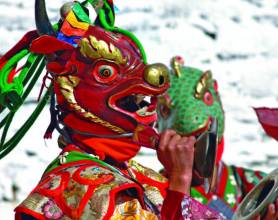Mask dance of the drums from Drametse
Inscribed in 2008 (3.COM) on the Representative List of the Intangible Cultural Heritage of Humanity (originally proclaimed in 2005)
Country(ies): Bhutan
Identification
Description

- The Drametse festival, held in honour of a Buddhist guru, is attended by people from Drametse as well as neighbouring villages. The highlight of this festival is the Drametse gacham, a sacred mask dance, introduced in the sixteenth century and performed ever since.
- © Yannick Jooris
The mask dance of the Drametse community is a sacred dance performed during the Drametse festival in honour of Padmasambhava, a Buddhist guru. The festival, which takes place in this eastern Bhutanese village twice a year, is organized by the Ogyen Tegchok Namdroel Choeling Monastery.
The dance features sixteen masked male dancers wearing colourful costumes and ten other men making up the orchestra. The dance has a calm and contemplative part that represents the peaceful deities and a rapid and athletic part where the dancers embody wrathful deities. Dancers dressed in monastic robes and wearing wooden masks with features of real and mythical animals perform a prayer dance in the soeldep cham, the main shrine, before appearing one by one in the main courtyard. The orchestra consists of cymbals, trumpets and drums, including the bang nga, a large cylindrical drum, the lag nga, a small hand-held circular flat drum and the nga chen, a drum beaten with a bent drumstick.
The Drametse Ngacham has been performed in the same monastery for centuries. Its form has both religious and cultural significance, because it is believed to have originally been performed by the heroes and heroines of the celestial world. In the nineteenth century, versions of the Drametse Ngacham were introduced in other parts of Bhutan. For the audience, the dance is a source of spiritual empowerment and is attended by people from Drametse as well as neighbouring villages and districts to obtain blessings. Today, the dance has evolved from a local event centred on a particular community into an art form, representing the identity of the Bhutanese nation as a whole.
Although the dance is highly appreciated among all generations, the number of practitioners is dwindling due to lack of rehearsal time, the absence of a system for training and the gradual waning of interest among young people.
Slideshow
Video
These videos (and many more) can also be consulted through the UNESCO Archives Multimedia website
Safeguarding project (10-2006/08-2009)
The Drametse festival, held in honour of a Buddhist guru, is attended by people from Drametse as well as neighbouring villages. The highlight of this festival is the Drametse gacham, a sacred mask dance, introduced in the sixteenth century and performed ever since.
The safeguarding project primarily seeks to create sustainable foundations for the transmission of skills and expertise related to the Drametse Ngacham to new generations of practitioners. It will also conduct research and collect existing knowledge and expertise concerning the choreography as well as raising awareness of the value of this tradition and the importance of safeguarding it. While the project will focus on the Drametse community, activities will also be conducted in other areas where the dance is performed. It will thus encompass activities such as training workshops for dancers (bringing together masters and dancers), teacher training and introducing the dance in schools. Other activities will include audiovisual documentation of knowledge and skills of old masters, compilation of existing documentation, as well as increasing public awareness through performances and publications.













































































